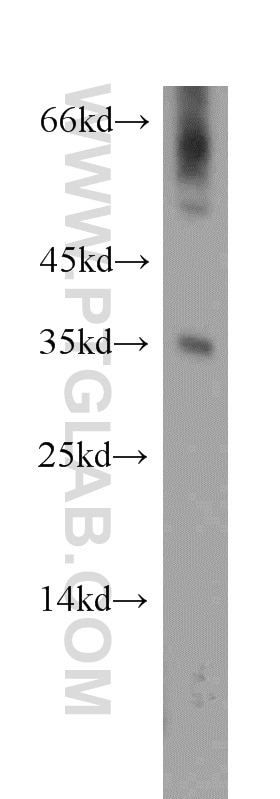DOK5 Polyclonal antibody
DOK5 Polyclonal Antibody for WB, ELISA
Host / Isotype
Rabbit / IgG
Reactivity
human, mouse, rat
Applications
WB, ELISA
Conjugate
Unconjugated
Cat no : 11948-1-AP
Synonyms
Validation Data Gallery
Tested Applications
| Positive WB detected in | mouse liver tissue |
Recommended dilution
| Application | Dilution |
|---|---|
| Western Blot (WB) | WB : 1:500-1:2000 |
| It is recommended that this reagent should be titrated in each testing system to obtain optimal results. | |
| Sample-dependent, Check data in validation data gallery. | |
Product Information
11948-1-AP targets DOK5 in WB, ELISA applications and shows reactivity with human, mouse, rat samples.
| Tested Reactivity | human, mouse, rat |
| Host / Isotype | Rabbit / IgG |
| Class | Polyclonal |
| Type | Antibody |
| Immunogen | DOK5 fusion protein Ag2615 |
| Full Name | docking protein 5 |
| Calculated Molecular Weight | 306 aa, 35 kDa |
| Observed Molecular Weight | 35 kDa |
| GenBank Accession Number | BC008992 |
| Gene Symbol | DOK5 |
| Gene ID (NCBI) | 55816 |
| RRID | AB_10665550 |
| Conjugate | Unconjugated |
| Form | Liquid |
| Purification Method | Antigen affinity purification |
| Storage Buffer | PBS with 0.02% sodium azide and 50% glycerol pH 7.3. |
| Storage Conditions | Store at -20°C. Stable for one year after shipment. Aliquoting is unnecessary for -20oC storage. 20ul sizes contain 0.1% BSA. |
Background Information
DOK5 belongs to the docking family of proteins that contain tandem pleckstrin homology-phosphotyrosine binding (PH-PTB) domains at their amino termini (PMID: 19909370). DOK proteins are also known as INS receptor substrates (IRS) and serve as substrates for INS and INS-like growth factor (PMID: 12730241 ) as well as various protein tyrosine kinases (PMID: 16647839). DOK5 functions as a specific signal transduction molecule and plays an important role in cellular differentiation. DOK5 is upregulated in systemic Sclerosis and Associated with IGFBP-5-Induced fibrosis (PMID: 24551065).
Protocols
| Product Specific Protocols | |
|---|---|
| WB protocol for DOK5 antibody 11948-1-AP | Download protocol |
| Standard Protocols | |
|---|---|
| Click here to view our Standard Protocols |


